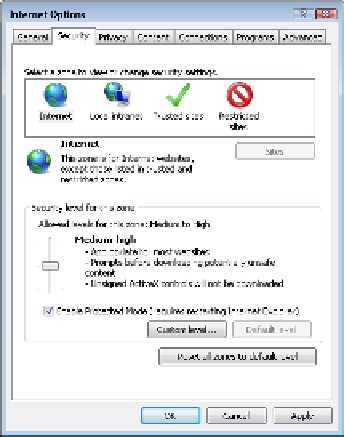Hardware Reference
In-Depth Information
Configuring Security Settings
Using the wrong security settings in your web browser can result in a variety of security
risks. Fortunately, in most browsers, you can easily set the most common security settings
by accepting the defaults.
In Internet Explorer, in the Internet Options dialog box, on the Security tab, you can drag
a slider to choose between Medium, Medium-High, and High security presets. Medium-High
is the best balance between functionality and security in most cases (see Figure 9.9).
FIGURE 9.9
Use the Medium-High setting for the Internet zone for most browsing
Another prudent security measure is to make sure Protected Mode is enabled for the
Internet and Restricted security zones on the Security tab in the Internet Options dialog
box. (It's that way by default.) Protected Mode prevents many different security exploits by
displaying content in a low-privileges mode.
You may also want to enable ActiveX Filtering. Some websites use ActiveX controls
to display content, but ActiveX can also be a security threat. Choose Tools
ActiveX
Filtering to toggle the fi lter on/off. When it's off, ActiveX controls are suppressed.
Controlling Cookies
A
cookie
is a plain text fi le that a web page (or an ad on a web page) stores on your hard disk
for tracking purposes. A cookie can tell an advertiser that you've previously viewed a certain
ad, for example, or can keep track of the items in your shopping cart on an e-commerce site.
Cookies are harmless 99.99% of the time, and they may actually perform useful
functions that you want. However, there are two risks involved with cookies. One is a
privacy threat: a cookie can deliver personally identifi able information to a website. The






